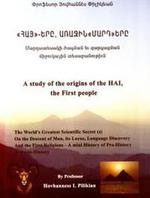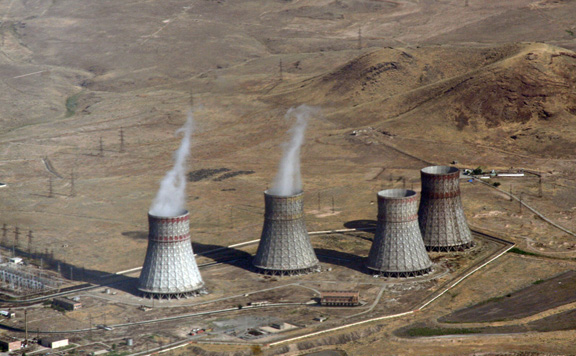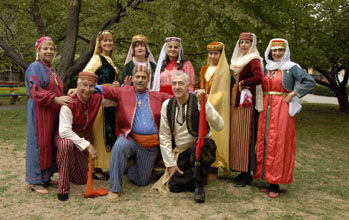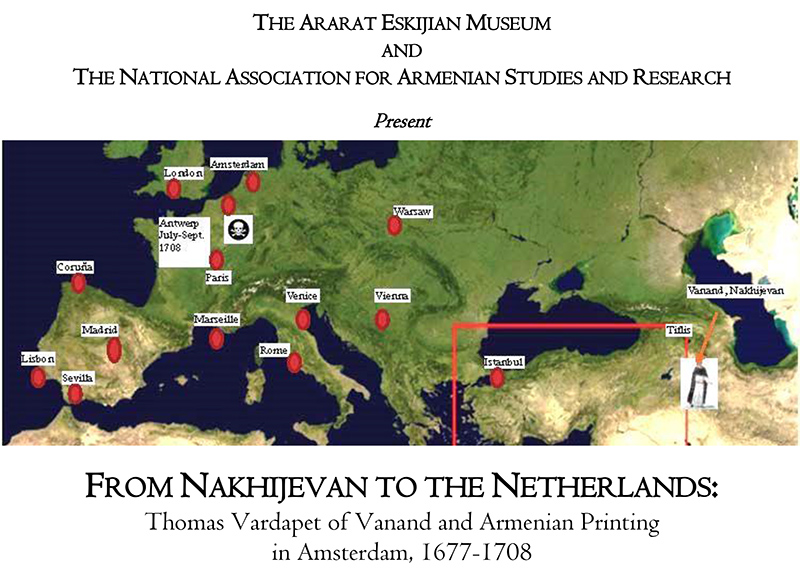One of the wonders of Prof. Hovhanness Pilikian’s “Origins of the Hai—the First People” is the author’s ability to impart so much new and stunning data and fact-based speculation within the slim volume.
The second wonder of the book is the polymath professor’s gutsy (some might say reckless) criticism of the Bing Bang theory and everyone from Charles Darwin to Western scholars who, the author says, push the British-French-German imperial and racist agenda by distorting the truth about the origins of mankind and the key role of the Armenian nation in that history. The same false paradigm is being maintained by the American neo-con promoters of globalization, according to the author. The professor, who speaks 11 languages, marshals his expertise as a social scientist and his scholarly knowledge of anthropology, psychology, linguistics, history, literature and music to shake many fundamental precepts of the Western view of mankind’s earliest history.
First of the London-based professor’s targets is Darwin. He says Darwin’s assumption that the first human originated in the African savannah is without basis. “…such totally boring landscape [savannah] is not conducive to initial human brain development in terms of potential intelligence,” he asserts. To develop physiologically, our brain needs challenging, exciting, varied environments found only in mountainous landscape. The author, citing a variety of factors, concludes that the Armenian Plateau must have been mankind’s alma mater. To back up his conclusion, Prof. Pilikian says the story of Noah’s flood “is not about the sinking of the earth in rain-torrents, but in actual fact its performative reverse—the appearance of the very first piece of land constructed by and surrounding the region of the cataclysmic volcanic eruption of the Ararat Mountains rising from under the oceans.” And when the oceans began to recede, Ararat appeared as the first land and the heartland of ancient Armenia. Subsequent eruptions resulted in the formation of the Armenian Plateau, Anatolia, the Middle East and the rest of the world’s surface.
The above scenario is a mirror image of the ancient Armenian poem about the birth of Vahakn, the god of fire.
“Heaven and Earth [exploding volcano in unimaginable force] were in travail [childbirth pains]
And the crimson waters [fiery red lava-flow] were in travail.
And in the water, the crimson reed [the fiery phallic column of the ejected lava] was also in travail…”
In a mind-boggling revelation, the author says the Noah’s Ark is a metaphor of a millennia-old buried scientific fact: the Armenian Highlands is Noah’s Ark. The highland is the fertile landmass after the outpouring of lava and ash-rain. Consequently, the first plants and animals and wo/mankind made their appearance around Ararat. “The Armenian Highlands, uniquely on this planet (with Tibet, on a miniscule scale in comparison) are the most massive massif, the hugest single plateau on top of volcanic mountain ranges,” writes Prof. Pilikian and points out that in a stylized cross-section, Anatolia’s profile reflects the image of Noah’s Ark. He concludes that the whole of ancient Armenia is the Ark of Noah.
The book’s next big theme is the worship of the sun cult, the first monotheistic religion. The author maintains that the sun was worshipped by the very first people—the Armenians. The cult, transmitted to ancient Egypt was transformed into the worship of sun god Ra, the oldest god of that country. The spelling of Ra is the Semitic dialectical reverse of the Indo-European AR (the root of Ar-ar-at). Prof. Pilikian somehow doesn’t mention that the word for sun is AR-ev/AR-ek in Armenian.
The third big theme of the book is the origin and explication of the word HAI. To analyze the word’s linguistic history, Prof. Pilikian uses the technique of sub-atomic particle physics. He postulates that H-A-I is the fundamental archetypal phonemic vowel—the quark proton in all languages…the very first phoneme in the universal grammar.” He also makes the interesting claim that all five vowels are rooted in the sound of “A.”
The book then links HAI to KhAi/KhI/KhUI and Khoi. Khoi (ram in Armenian), an Armenian god, is phonetically connected to Cor-inth, A-ch-r-nians, A-chai, Io-nians, A-chae-manians. The Hittites called themselves the Kha-tti. The Greek word for Earth is Gaia (KHAI-A) “acknowledging the original earth of the Pangaea to have been the locus and the trope, the land of the HAI in the Ararat Region,” says Prof. Pilikian. Exploring the family tree of the word KHA-I, the author also sees links with the Phoenician Ca-dmus (a man of Khai… man from Ararat). Cadmus introduced the alphabet to Greece. The 5th century Armenian historian Movses Khorenatsi (“History”) has written that Cadmus was the grandson of the Armenian patriarch HAI-k, the plural of HAI in classical Armenian.
Prof. Pilikian maintain that the whole of the Greek alphabet—and consequently all the alphabets of the world—are graphic designs, pictorial representations of the variety of Khoe-Ram horns. In the Van dialect of Armenia, the alphabet is called Ai-ds-a-kir (goat letter). This leads the author to conclude that the first alphabet was conceived in the Armenian Highlands.
Digging deeper into the significance of the HAI phonetics, the professor points out that A-I is the sound of ontological pain, the first scream of a newborn child. “The same linguistic fossil preserves a mind-blowing history of thousands of millennia of mankind’s pre-history recording technological advances and habitation,” he says.
From there the book connects HA-I to AI-R. In Armenian the latter word means man or undifferentiated gender, kar-air (cave) and is the root of air (burn). Thus the reader observes connections between man, dwelling, and fire, all rooted in HAI.
Continuing his one-man campaign of shibboleth shattering, Prof. Pilikian says Hebrews and Arabs originated in the Armenian Plateau. He also notes connections between the Hebrew Jehovah/IAH-WAH and the Arabic All-h with HA-I and asks whether the South African Khoi people originated in Armenia. A possible relationship between Khoi and Kalahari is another observation. The author speculates that the pyramids of Egypt (like the Tower of Babel) are copies of Ararat and that the natives of Japan’s Hokkaido Island might have been originally Armenian. To buttress his case, the professor provides a number of linguistic and anthropological clues.
In his conclusion the daring author postulates that the true Garden of Eden is the whole world, not a fantasy somewhere in afterlife. Citing the Hebrew Bible, the author states that the Kingdom of God must be built here on earth and adds, “and it is we, wo/mankind that through our ignorances and stupidities turn this life-god-given paradise into genocidal hell, only and only because of unnecessary, futile, foolish, Capitalist greed…”
To purchase the book, contact the Assembly of Armenians of Europe in Uppsala, Sweden at www.aaeurop.com










